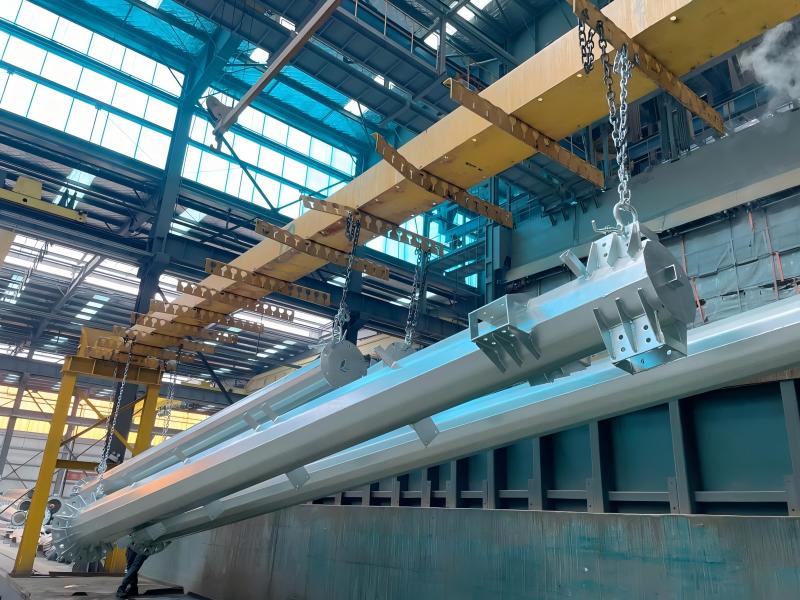For decades, concrete poles were the familiar backbone of low-voltage power distribution. But look around newer installations or upgraded grids today, and you'll increasingly see sleek, galvanized steel tubular poles taking their place. This shift isn't just aesthetic; it's driven by compelling technical and economic advantages. Let's break down why steel tubular poles are becoming the new standard.
1. Material Performance: Strength & Stiffness Where It Counts
Concrete Poles: Concrete excels in compression but is inherently brittle and weak in tension. This makes it vulnerable to cracking from impact (vehicle collisions, falling branches), ground movement, or even internal stresses. Its stiffness is fixed once cast.
Steel Tubular Poles: Steel offers exceptional tensile strength and toughness. It bends significantly before failing, providing inherent resilience against impact and wind loads. Its high stiffness combined with ductility allows it to absorb energy safely. The tubular design efficiently distributes loads, maximizing strength with minimal material.
Winner: Steel. Superior tensile strength, ductility (safety), and resilience make it fundamentally better suited for the dynamic loads poles face.
2. Strength-to-Weight Ratio: A Game Changer
Concrete Poles: Heavy! A typical 10-12m concrete pole for LV lines can weigh 300-500 kg or more. This bulk dictates everything else.
Steel Tubular Poles: Dramatically lighter. A comparable steel pole might weigh only 100-200 kg – often 3-5 times lighter for the same functional strength and height. This high strength-to-weight ratio is perhaps steel's most significant advantage.
Winner: Steel. By a massive margin. This lightweight nature cascades into benefits across installation, transport, and foundation needs.
3. Lifespan & Durability: Built to Last (with Protection)
Concrete Poles: Susceptible to weathering, freeze-thaw cycles, and corrosion of internal reinforcement (rebar) if cracks allow water ingress. Spalling (surface chunks breaking off) is common over time, weakening the structure. Lifespan is typically 30-50 years but can be shorter in harsh environments.
Steel Tubular Poles: The key is hot-dip galvanization. This thick, bonded zinc coating provides exceptional, long-term corrosion protection, easily lasting 50+ years in most environments. The steel itself is inherently resistant to weathering and freeze-thaw damage. Minor surface scratches don't compromise the entire structure like cracks in concrete.
Winner: Steel. With proper galvanization, steel poles offer superior, predictable longevity and lower maintenance needs.

4. Installation Efficiency: Speed and Simplicity
Concrete Poles: Require heavy lifting equipment (cranes) due to their weight. Foundations often need significant excavation and concrete pouring, curing time, and backfilling. Handling is cumbersome and potentially hazardous.
Steel Tubular Poles: Their light weight allows for installation using smaller, more maneuverable equipment (e.g., bucket trucks with augers/hoists). Foundations are much smaller and simpler – often just drilled holes with compacted backfill or small concrete pads. Factory prefabrication ensures consistent quality and includes pre-drilled holes for accessories, speeding up assembly on-site.
Winner: Steel. Faster installation, reduced labor, less disruptive groundwork, and lower equipment requirements translate to significant project time savings.
5. Cost-Effectiveness: Looking Beyond the Initial Price Tag
Concrete Poles: Often have a lower initial purchase price per pole. However...
Steel Tubular Poles: While the unit pole cost might be slightly higher, the total installed cost is frequently lower or competitive due to:
Drastically reduced foundation costs (less excavation, less concrete).
Faster installation (lower labor and equipment rental costs).
Reduced transportation costs (more poles per truckload).
Lower long-term maintenance costs (less susceptibility to damage, no spalling repairs).
Longer lifespan reduces replacement frequency.
Winner: Steel. Offers superior lifecycle value. The savings in foundations, installation, and maintenance often outweigh the slightly higher material cost.
The Driving Forces: Why the Shift is Happening Now
Space Constraints & Urbanization: Steel poles' smaller foundations and ability to be installed closer to obstacles are crucial in dense urban areas and congested rights-of-way.
Resilience Demands: Superior strength and ductility make steel poles more resistant to extreme weather events (high winds, ice) and accidental impacts, improving grid reliability.
Rapid Deployment Needs: The speed of installation is vital for grid upgrades, expansion projects, and disaster recovery.
Total Cost Awareness: Utilities increasingly prioritize lifecycle costs over simple upfront costs, recognizing the long-term savings steel offers.
Aesthetics (Bonus): Steel poles offer a cleaner, more modern appearance, which is often preferred in community settings.
Conclusion: A Superior Solution for Modern Grids
The transition from concrete to steel tubular poles in low-voltage networks isn't a fleeting trend; it's a rational response based on clear engineering and economic advantages. Steel's superior material properties – especially its high strength-to-weight ratio – combined with the benefits of factory prefabrication, easier installation, proven long-term durability through galvanization, and compelling lifecycle cost savings make it the smarter choice for building resilient, efficient, and cost-effective power distribution infrastructure for the future. While concrete poles served well historically, steel tubular poles represent the technological evolution needed for modern grid demands.
Learn more at www.alttower.com